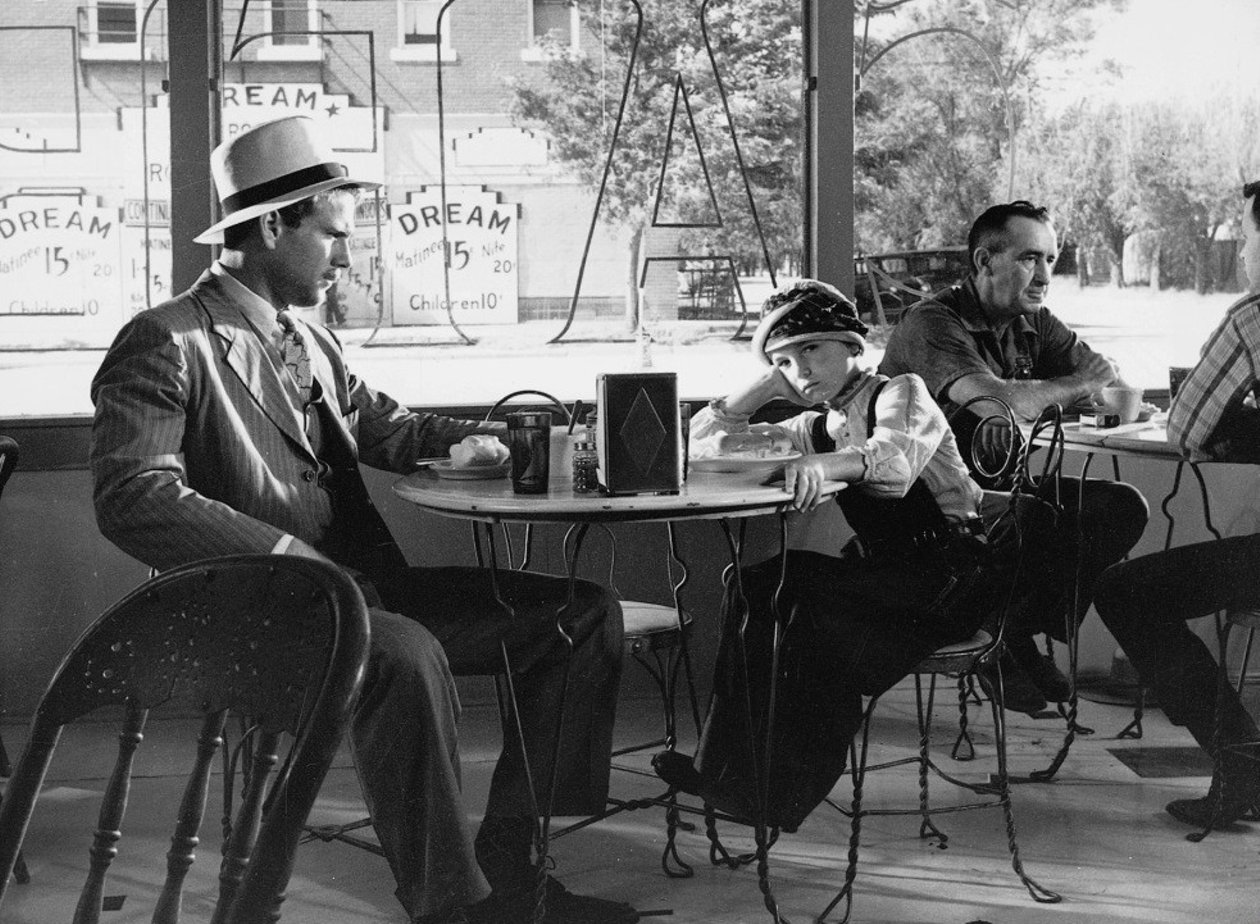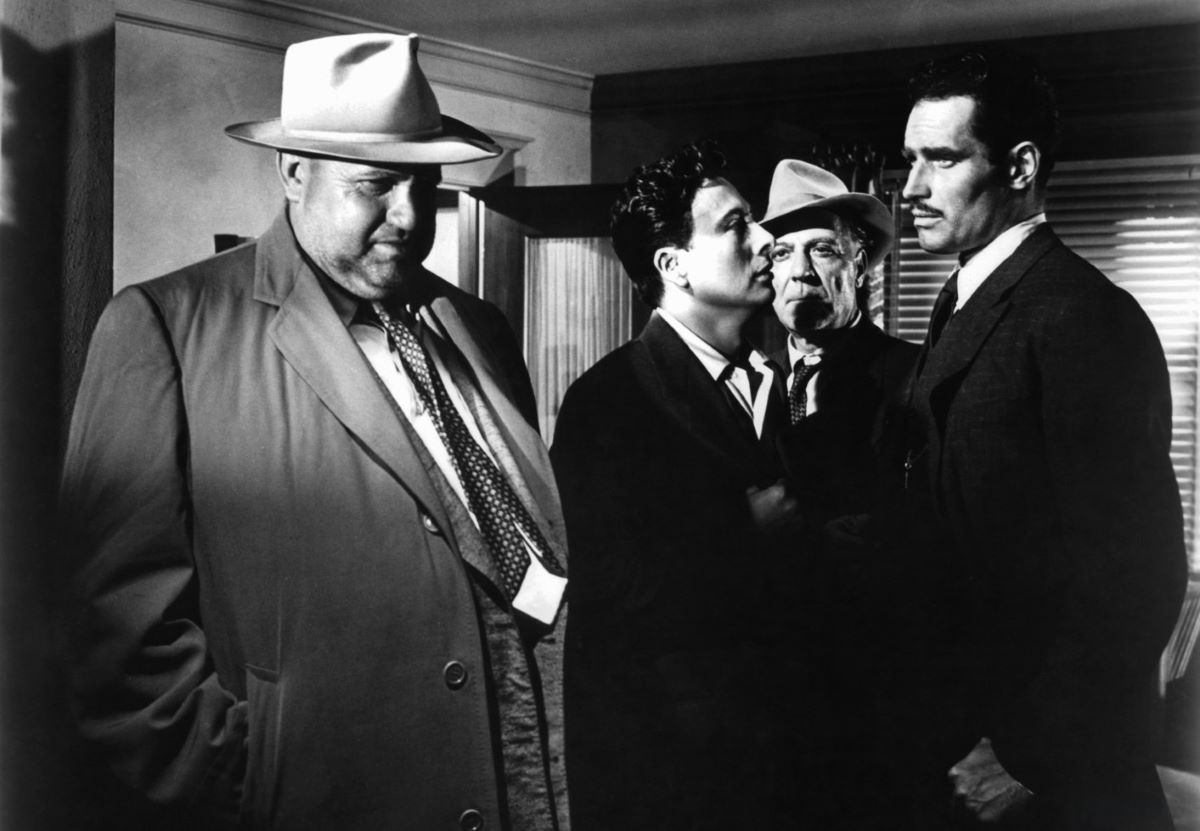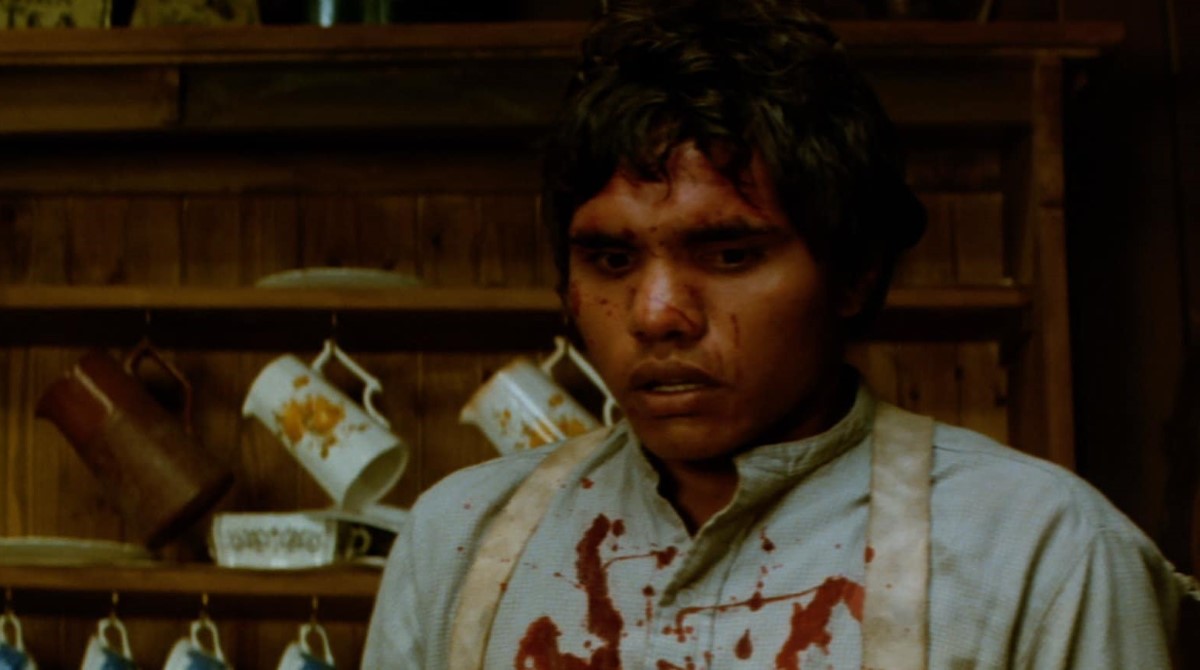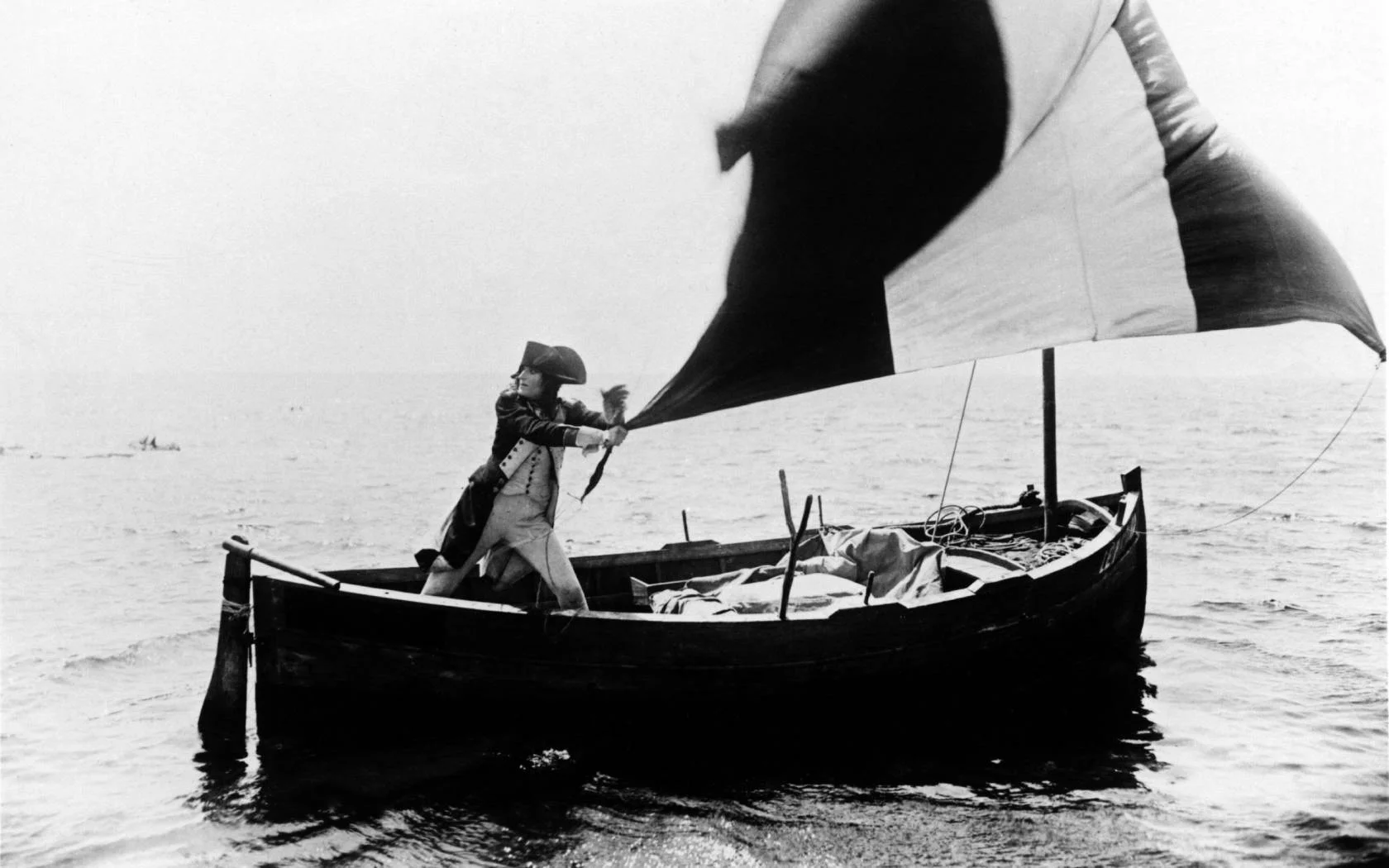Paper Moon, directed by Peter Bogdanovich and released in 1973, is a heartwarming yet comically charged road movie set against the backdrop of the Great Depression. Adapted from Joe David Brown’s novel Addie Pray, the film stars Ryan O’Neal and his real-life daughter Tatum O’Neal, delivering memorable performances that earned Tatum an Academy Award for Best Supporting Actress.
The story follows Moses Pray (played by Ryan O’Neal), a small-time con artist and traveling Bible salesman navigating the impoverished Midwest during the Great Depression. The narrative takes an unexpected turn when Moses is approached by Addie Loggins (played by Tatum O’Neal), a wise-beyond-her-years nine-year-old who claims to be the illegitimate daughter of Moses’s deceased former lover.
Addie quickly convinces Moses to take her along, suspecting he may be her real father. Initially resistant, Moses eventually warms to the idea, realizing that having Addie by his side could open new avenues for his dubious schemes. The duo embarks on a misadventure-filled journey across Kansas and Missouri, their escapades fueled by Addie’s street-smart instincts and Moses’s questionable charm.
The heart of the film lies in the evolving relationship between Moses and Addie, a dynamic that oscillates between camaraderie and conflict. Despite Moses’s dubious profession, a genuine father-daughter bond begins to form, and the audience witnesses their shared moments of laughter, frustration, and, ultimately, mutual affection.
The central plot device is Moses’s latest con job, selling Bibles to recently widowed women. Moses and Addie’s journey takes a hilarious turn when they encounter the wealthy and gullible Mrs. Imogene Hooper (played by Madeline Kahn), a widow mourning her husband. The duo’s schemes become increasingly elaborate, and their interactions with Mrs. Hooper add both comedic and emotional depth to the narrative.
As their journey unfolds, Moses and Addie’s lives become entangled with various characters, each contributing to the film’s rich tapestry. Notably, a scene-stealing performance by P.J. Johnson as the burlesque performer Trixie Delight adds a layer of complexity to Moses’s character and further explores the theme of makeshift families formed in the face of adversity.
The film’s climax is marked by a poignant turning point, challenging Moses and Addie’s relationship and underscoring the theme of personal growth. The resolution offers a blend of emotional resonance and humor, showcasing the resilience of the human spirit even in the direst of circumstances.
Paper Moon is visually distinctive, capturing the stark landscapes of Depression-era America through the lens of cinematographer László Kovács. The black-and-white cinematography enhances the film’s nostalgic atmosphere, echoing the iconic imagery of the time.
Central to the film’s success is the remarkable chemistry between Ryan O’Neal and Tatum O’Neal, whose real-life father-daughter relationship translates seamlessly on screen. Tatum’s portrayal of Addie earned her critical acclaim and an Academy Award, making her the youngest winner in an acting category in Oscar history.
* * *
Reviews
by Judith Crist
The world, let alone Watergate, is so much with us that amid a clutch of “thesis” movies one opts for the simple, the sweet, and the pleasurable.
And the last, happily, comes from Peter Bogdanovich in beautiful, relaxing and appropriate black and white. Paper Moon, his fifth and most recent film, is exactly what we have in mind when we talk nostalgically of what movies “used to be”—meaningful rather than metaphorical, engrossing rather than exploitative, humanistic in their comedy and their sentiment. Indeed there will be those cineastes who will declare that this is a used-to-be movie, with shades of The Kid, The Champ, Little Miss Marker—if not hommages to the makers thereof. They’re right as far as genre goes—a basic theme is, of course, that of the waif and the con man, the child up against the hard heart and larcenous leanings of the adult. But as Bogdanovich has shown in the progression of his films, along with a steady growth of professionalism and ripening of talent, through Targets, Directed by John Ford, The Last Picture Show, and What s Up, Doc?, he is artist enough to make his personal mark upon a genre.
Based loosely on Addie Pray, a novel by Joe David Brown, with a screenplay by Alvin Sargent, Paper Moon is the story (a love story, perhaps, or a story of love) of a nine-year-old orphan and a small-time confidence man making their way through a Depression-bleak Kansas en route to her aunt’s in St. Joseph, Missouri. The Panama-hatted slick-suited gent is a Bible salesman, working the widow racket, and they meet at her mother’s graveside. Since he’s on his way to St. Jo, why not take the girl to her only surviving relative? He agrees—and in no time has gently blackmailed a chap in town into giving the child $200 in compensation for her mother’s death and spent a chunk of it on refurbishing his roadster; he’s about to put her on a train for St. Jo with $20 cash when suddenly he sees the child plain. “You owe me $200,” she declares. And he has met his match.
Moses Pray’s match is about four feet tall, a hideous cloche pulled down to her eyebrows, sexless in overalls, firm-jawed and bass-voiced, clutching a cigar box packed with her treasures, chief among them a bottle of perfume and a snapshot of her mother, a posturing, cheap and pretty belle in the same cloche. And Addie has a perceptive eye, a mind like a calculator, a bent for smoking in bed, a passion for Jack Benny and Fibber McGee, a cool head for business, and a yearning for tenderness. But in eternal-woman fashion, she’s up against a total stinker, a foolish, cowardly, petty crook without an honest instinct or a non-egocentric emotion. He’ll earn and repay the $200—if he won’t, Addie will scream—but not an iota more will he give.
And so the two set out and before you know it, Addie’s running the business. True, there’s a bit of a setback when Moses gets himself besotted by Trixie Delight, a carnival dancer of good family, and near-disaster when he gets into bootlegging. But you can bet on Addie all the way.
Addie is portrayed by a nine-year-old named Tatum O’Neal—and only a father would be willing to co-star with this technically amateur but actually top-pro picture-stealer. And indeed, it is her father, Ryan O’Neal, who not only cooperates in her large case of larceny but in the course thereof proves himself a first-rate character actor.
Bogdanovich’s basic triumph is in keeping the film unsentimental, unslapstick, and unstrained. Laszlo Kovacs’s camera has captured so completely a sense of time and place, of a poverty-stricken Midwest and a Depression era whose hopes are fed by Addie’s idolized “Frankie Roosevelt” and of an age of relative innocence, that one is transported in the watching. And the casting is impeccable, beyond the O’Neals, with Madeline Kahn, that deliciously nasal fiancee from Iowa in What’s Up, Doc?, sheer delight as the whorish and pathetic Trixie with highfalutin talk of bone structure and a bitter awareness of her shaky holding power; P. J. Johnson as Trixie’s stolid slave who accepts the burdens of hard times and the joys of emancipation with equal patience; Burton Gilliam as a gamy desk clerk—and lots more, with every face a part not only of the scene but of the era. And again Bogdanovich has used period music within its context as the final seal on our nostalgia. We can revel in Paper Moon as a reminder that the good things of film not only used to be—but are.
New York, May 21, 1973
* * *
by Gary Arnold
Paper Moon may prove a disappointment if you go with sizable expectations. At its best the film is only mildly amusing, and I’m not sure I could recall a few undeniable highlights if pressed on the point.
Several supporting and bit players are enjoyable for the brief moments they occupy the screen: John Hillerman in the dual role of a bootlegger and his sheriff brother; Burton Gilliam as a lecherous desk clerk; Dorothy Price and Dejah Moore as swindled saleswomen; P. J. Johnson as the teenage maid of a prattling trollop, a would-be hilarious role that has been grotesquely overplayed by Madeline Kahn, evidently at the insistence of director Peter Bogdanovich.
None of these performers happens to be critically important, indispensable to the action and appeal of the story. The problem with Paper Moon is that it’s hollow at the center. The central relationship, involving a smalltime con man and a tough little girl who practice a Bible-selling racket in the Midwest during the Depression, remains undeveloped and unaffecting.
Having tried without success to maintain some interest in the source of material, Joe David Brown’s novel Addie Pray, I was prepared for certain inadequacies in the story. Addie Pray seemed like a synthetic imitation of True Grit: Brown affected Charles Portis’s vernacular style but failed to reproduce the charm and originality. The tone was reminiscent, but the kick was gone. Apart from its literary charms, True Grit was also an exciting adventure melodrama. Nothing particularly compelling happens in Addie Pray. It’s an episodic account of some negligible-to-pathetic swindles, scarcely comparable to Mattie Ross’s relentless pursuit of the men who murdered her father.
Alvin Sargent’s screenplay retains the episodic structure of Brown’s book, and the film suffers from a lack of either strong episodes or a strong line of dramatic development. The truly surprising weakness is the failure to create a touching, ongoing relationship between the country con man, played by Ryan O’Neal, and his orphaned kid accomplice, played by O’Neal’s nine-year-old daughter Tatum. The substance is so thin and the movie treatment so superficial that nothing emotionally lasting takes hold, not even an implicit sense of affection between father and daughter.
O’Neal, adorned with a mustache and garbed in thirties duds, bears an occasional agreeable resemblance to Warner Baxter and Clark Gable, but his performance has no style or authority. He acts rather uptight and flustered. There was never a moment when I believed that his character had either the gall or the charm he would need to have to survive.
The press material for the film includes a comment by Bogdanovich that O’Neal wanted to do the role with a Southern accent but was dissuaded, because Bogdanovich felt the accent would “soften” the character and fail to convince the audience. But O’Neal is not convincingly tough as it is, and perhaps an accent would have given him a useful handle on the role, a ready means of stylizing his character. It’s now apparent that O’Neal desperately needs some method of individualizing the role.
An actor like Gable would surely have been a little playful and ingratiating when impersonating a con man, and one would like to see Ryan O’Neal take a similar tack. I suspect that O’Neal became too concerned with Tatum’s level of performance to concentrate on having a good time in his own part. A harmless device like an accent might have helped to loosen him up.
Considering the box-office success of What’s Up, Doc? and the probable success of Paper Moon, it sounds rather preposterous to suggest that Peter Bogdanovich and Ryan O’Neal may not be right for each other, but I don’t think they are right for each other. O’Neal has not been at his most attractive doing humorless derivations of old Cary Grant and Clark Gable assignments, while Bogdanovich, extraordinarily capable with the straightforward dramatic material of The Last Picture Show, is inclined to strain and miscalculate when he undertakes the breezier forms of motion-picture entertainment. Bogdanovich’s luck will probably hold: If What’s Up, Doc? can be mistaken for a heady revival of screwball comedy, Paper Moon can be just as easily mistaken for a heartwarmer. It isn’t, but it should be, so audiences may feel like making the necessary allowances.
I wanted to be more impressed and affected by Tatum O’Neal than I was. The most disappointing aspect of the film in my opinion is the lack of anything noticeably original or moving about either her personality or performance. Perhaps the reviewers who have been raving about her should take a look at Hayley Mills in her first movie, Tiger Bay (a little girl-loves-outlaw story that has the kind of conflict, suspense, and sentimental appeal Paper Moon could use), or Margaret O’Brien in Meet Me in St. Louis, or Butch Jenkins in The Human Comedy, or John Howard Davies in Oliver Twist and The Rocking Horse Winner, or Jean-Pierre Léaud in The 400 Blows, etc., etc.
Miss O’Neal has a pleasantly round, tomboyish mug, and when she smiles, she suddenly becomes an endearing spittin’ image of her father. She’s obviously meant to recall Jackie Coogan in The Kid, but she doesn’t project remotely as much expression or intensity. Tatum O’Neal has a surprisingly reserved screen presence. One enters the theater anticipating a terrific new image of a tough, lovable kid, but this little girl acts unusually subdued and self-conscious, as if she were trying hard to remember her lines and deliver them precisely on cue.
The script doesn’t give Tatum O’Neal the opportunity for much variety. Most of the time she merely acts a little stubborn or belligerent. The camera catches her far too often with the same slightly pouting, tight-lipped expression on her face. If there’s something more exciting or vibrant or uninhibited in her personality, Bogdanovich has failed to bring it out. P. J. Johnson, the unheralded supporting kid in the cast, is more interesting to watch, because she looks and sounds like an original—a somewhat lumpy, big-boned girl with an offbeat vocal delivery. While I’m sure Tatum O’Neal is a good, lively kid, I hope she doesn’t believe her reviews, because those raves have been more than a little premature.
Washington Post, June 15, 1973
* * *
by Roger Ebert
The two kinds of Depression-era movies we remember best are the ones that ignored the Depression altogether and the ones like The Grapes of Wrath that took it as a subject. Peter Bogdanovich’s Paper Moon somehow manages to make these two approaches into one, so that a genre movie about a con man and a little girl is teamed up with the real poverty and desperation of Kansas and Missouri, circa 1936. You wouldn’t think the two approaches would fit together, somehow, but, they do, and the movie comes off as more honest and affecting than if Bogdanovich had simply paid tribute to older styles. Maybe that’s why Addie Loggins, the little girl, hardly ever smiles: She can see perfectly well there’s nothing to smile about. The movie opens at her mother’s funeral on a windswept plain. Her mother (we learn from an old photograph) was a flapper of the worst sort, but Addie is a tomboy in overalls and a flannel shirt. At the last moment, an old car comes rattling up and discharges one Moses Pray, con man, alleged Bible salesman and just possibly Addie’s father. He promises to deliver the child to relatives in St. Joe, mostly so he can collect $200 in blackmail money.
But then the 9 year-old girl, who somehow resembles Huckleberry Finn more than any little boy I can imagine, turns out to be the more clever con man, and before long they’re selling Bibles to widows who are told their husbands ordered them – deluxe editions with the names embossed in gold, of course – before “passing on.” The movie is about two con artists, but not really about their con, and that’s a relief. We’ve seen enough movies that depended on the cleverness of confidence tricks – not only 1930s movies, but right down to the recent The Flim-Flam Man. No, Bogdanovich takes the con games only as the experience which his two lead characters share and which draws them together in a way that’s funny sometimes, but also very poignant and finally deeply touching.
By now everybody knows that Ryan O’Neal and his real-life daughter, Tatum, play the man and the girl. But I wonder how many moviegoers will be prepared for the astonishing confidence and depth that Tatum brings to what’s really the starring role. I’d heard about how good she was supposed to be, but I nevertheless expected a kind of clever cuteness, like we got from Shirley Temple or young Elizabeth Taylor. Not at all. Tatum O’Neal creates a character out of thin air, makes us watch her every moment and literally makes the movie work (in the sense that this key role had to be well played). She has a scene in a Kansas hotel, for example, that isn’t at all easy. Moses has picked up a tart from a sideshow, one Trixie Delight by name, and has designs on her. Addie is jealous and makes a liaison with Trixie’s young black maid, Imogene (wonderfully played by P. J. Johnson). Together they concoct a scheme to lure the hotel clerk into Trixie’s room and then inform Moses.
Now this could have been a hotel-corridor farce scene, as Bogdanovich demonstrated he could direct quite well in “What’s Up, Doc?” But this time, the scene is played for pathos and for the understanding of the child’s earnestness, and the two young girls are perfectly matched to it.
Paper Moon doesn’t come off, then, as a homage to earlier beloved directors and styles (as Bogdanovich’s What’s Up, Doc? did – and his The Last Picture Show, to a smaller extent). No, it achieves something quite different: a period piece that uses generic conventions only when they apply, so that we see the Depression through the eyes of characters who are allowed to be individuals. Whatever Addie and Moses do in this movie, we have the feeling it’s because they want to (or have to) and not that the ghost of some 1930s screenwriter is prompting them.
Chicago Sun-Times, June 15, 1973
* * *
He’s just mad about Addie
by Gene Siskel
I’m in love with a nine-year-old girl.
Her name is Tatum O’Neal; she’s Ryan’s daughter by his first wife [actress Joanna Moore]; and she is the beguiling star of Peter Bogdanovich’s most enjoyable fourth feature film, Paper Moon.
The first thing that strikes you about Paper Moon is that, like Bogdanovich’s “The Last Picture Show, it has been filmed in black and white. For a film set literally on the highways and biways of the Middle West during the tail end of the Depression, it is a natural and sensible choice. Few visual effects in film are as chilling and strangely stirring as a broad expanse of gray-colored flatland that meets, a whiter shade of cloud-streaked sky.
Bubbling under the somber skies of “Paper Moon” is a tender comedy, the story of a Bible hustler [Ryan O’Neal] soon outhustled by a brassy, parentless little girl [Tatum O’Neal]. After forming an uneasy partnership based on his car and her wits, Moses and little Addie run cross-country string of scams from five-dollar bill-changing swindles to $500 theft of bootleg whisky. But their success as a bunko team ultimately is secondary to their growing affection for each other, and the picture hangs on whether their relationship will last.
The film is pockmarked with small mistakes—period detail continually is thrust in our faces, Miss O’Neal occasionally is given arch, melodramatic dialog, which undercuts her passionate spontaneity—but they cannot dim Miss O’Neal’s performance … or is it her essence?
She is more than cute. Her role is something special in the well-established tradition of children on film. Children in better American movies—Shane and The Last Picture Show, for example—usually are presented as confused little people hungering for an ideal father figure. And to the degree that members of the audience are themselves still searching for a spiritual father, an ideal code of conduct, the child becomes the locus of their identification with the movie.
Children in European films typically serve a different function. In Italian films—De Sica’s The Bicycle Thief is a prime example—the child, more often than not, is an unspoiled innocent, not yet corrupted by the world, standing as a moral reminder of the purity an adult should seek to regain.
The character of Addie in Paper Moon is a hardy mixture of both these traditions. She is a swindler, no doubt about it—and therein lies her perverse, contemporary charm — but she also is more moral than her adopted father, forever demanding that he act with compassion, that he differentiate between their marks’ need for money. In that way she is more like an adult bottled up inside a children’s size 10 dress.
If that analysis leaves you with the impression that Paper Moon is a somber, message picture, I apologize. It’s just that it is distinguished by its moral tone, and it is the tone that lifts it above the average flim-flam comedy.
Two other performances deserve comment. One is that of Ryan O’Neal, whose presence continually reminds us that Paper Moon is just a movie, and a Hollywood production at that. Part of the problem is an improbable, half-grown mustache. More damaging: in a picture filled with unfamiliar, forlorn faces, O’Neal’s fan-magazine kisser breaks the period realism that Bogdanovich tries so hard to evoke.
And than there’s a young lady I don’t recall having seen in a movie. Her name is P. J. Johnson, and as the hand-maiden slave to a carnival stripper she brings a brashness to the screen that frequently eclipses that of even Tatum O’Neal.
Credit for the performances of the Misses Johnson and O’Neal must be shared with director Bogdanovich, who displays [as in The Last Picture Show] a talent for revitalizing the morality and visual style of films long past.
Best of all, in Paper Moon he does that while making us smile.
Chicago Tribune, June 15, 1973





